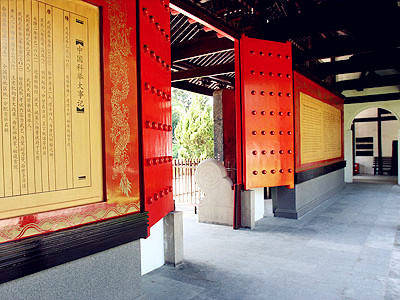
Route I
Jiading Confucius Temple (Shanghai Museum of the Chinese Imperial Examination System) – Huilongtan – Zhouqiao Old Street –Xiangdong Museum of Buddhist Art
Route II
Jiading Confucius Temple (Shanghai Museum of the Chinese Imperial Examination System) –Jiading Bamboo Carving Museum – Zhouqiao Old Street –Qiuxia Pu (Qiuxia Garden)
Route III
Huilongtan –Jiading Confucius Temple (Shanghai Museum of the Chinese Imperial Examination System)– Zhouqiao Old Street
【Confucius Temple】
Jiading is known as a "state of education", and the Confucius Temple is the source. According to historical records, Jiading had, since the initiation of the imperial examination system, fostered 192 imperial scholars, including three champions in the imperial examinations. Jiading has a strong background for culture and education and is known as the birthplace of talents and men of letters.
Construction of the temple took 30 years, beginning in the 12th year of the Jiading reign of the Southern Song Dynasty (1219), which was the second year after Jiading was officially named a county. It was principally completed in the ninth year of the Chunyou reign of the Southern Song Dynasty.
In the following 800 years, the Confucius Temple, covering an area of about 1.13 hectares, underwent 10 massive renovations during various dynasties. As a result, it has been quite well preserved.
【Huilongtan】
Walking out of the Confucius Temple and crossing Binxing Bridge, an ancient bridge built during the Chunyou reign of the Song Dynasty (960 - 1279), visitors can arrive at Huilongtan Park. Huilongtan Pond was dredged in the 16th year of Emperor Wanli of the Ming Dynasty (1588). Five rivers, like zigzagging dragons, converge here at the pond, hence the name Huilongtan Pond ("converging dragons").
In the pond, there is an island named Mount Kuishan surrounded by crystal clear water. Looking around from the island, it is like a picture of five dragons vying for a pearl. A beautiful mountain-water landscape unfolds before one's eyes.
Huilongtan Park was built in 1928 and was then called Kuishan Park. At the lakeside, there is Kuixing Tower with multi-layer eaves; on the top of the mount sits Zhuangyuan Tower hidden in woods in response to the decorative archway of the lecturing hall of the Confucius Temple. There are also monuments to Tongzeng, a royal official of the Ming Dynasty, and Huang Chunyao, as well as historical sites and cultural relics such as stone pavilions, stone towers and stone peaks from the Song, Yuan, Ming and Qing dynasties, which are all well preserved. The manmade and natural landscapes are well blended here in the park.
【Qiuxia Pu (Qiuxia Garden)】
As one of the five classical gardens in Shanghai, Qiuxia Garden is the oldest and best conserved. It was built from the 14th year of Emperor Chenghua to the fifth year of Emperor Jiajing of the Ming Dynasty (1505-1526), and served as the private garden of the mansion of Gong Hong, minister of works of the Ming Dynasty.
Qiuxia Garden, designed artistically and delicately with an elegant composition, is highly reputed for its breathtaking beauty. There are many couplets and inscriptions by celebrities in the garden. In 1962, the garden was listed as a Shanghai Municipality Protected Historic Site
【Anting Old Street】
Located northwest of the international auto city, the street is of typical southern China style. With overall renovations in the past years, Anting Old Street has regained its charms and styles of the Ming and Qing dynasties, and has developed its unique "road-river-street" pattern with the Anting River as the axis and with the ancient Yansi Bridge of the Ming Dynasty (1368 -1644) as the center. In the street, the nine-story Yongan Tower, 52.88 meters tall, was newly constructed for skyscraper view.
The ancient Bodhi Temple of the Three Kingdoms Period was reconstructed, and shopping, leisure and catering facilities such as shops reflecting the old street culture, souvenir shops for auto city tourists and traditional snack food restaurants were opened along the street. Strolling in the Anting old street, it gives visitors a sense of stepping into the past. Old shops, with red walls and black tiles, line along the street.
【Jiading Bamboo Carving Museum】
The Jiading Bamboo Carving Museum is located in Jiading Villa, a historical and cultural protection site. The exhibition is 108 meters long.
The museum houses a number of masterpieces collected from various sources, including both organizational and individual collectors. It is open to the public for free.
Jiading bamboo carving has a 400-year history, dating back to the Ming Dynasty (1368-1644). The earliest creator Zhu He, together with his son and grandson, created and developed Jiading style bamboo carving that featured techniques such as deep relief and transparent relief. The art is full of cultural value and has regional characteristics.
Jiading bamboo carving was included into the first national catalogue of intangible cultural heritages in 2006.
The museum provides a charming journey through the art of bamboo carving for visitors at home and abroad with a full range of treasures. It will also give life to the art form, which is in danger of extinction, by utilizing collection, exhibition and research.
【Zhouqiao Old Street】
Zhouqiao Old Street has long been the most prosperous area since Jiading county was founded in the Southern Song Dynasty in 1218. The street not only boasts picturesque scenery – characterized by little bridges, murmuring brook and peaceful households – but also enjoys rich historical resources – featuring famous parks, old towers and temples. It is a rare but perfect combination of natural and cultural elements.

